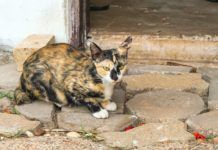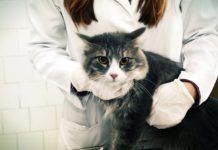Dear Doctor – A readers complex question
My four-year-old cat, Stripe, has been diagnosed with an overactive immune system. Last year, he had surgery to remove a cranial lung lobe and the biopsy found the necrotic mass to be non-malignant. Chronic lymphoplasmacytic inflammation was the diagnosis.
The Discomfort of Feline Joint Disorders
A healthy cats impressive physical traits - her strength, agility and lightning-fast responses to external stimuli - are essentially attributable to the structure and versatility of her musculoskeletal system. However, the feline musculoskeletal system is also subject to a variety of disorders that can seriously compromise a cats comfort and agility, as well as the performance of necessary bodily functions. Unfortunately, such disorders often defy prompt recognition and treatment.
Understanding Anemia in Cats
Like every veterinarian, I evaluate the mouth and gums of my patient whenever I perform a physical examination. I expect to find nice pink gums, and most of the time, I do. Occasionally, Ill note with dismay that the gums are pale, or even white. This finding immediately sets off alarm bells in my head: This cat is anemic. The task of making a diagnosis now begins.
The Threat of Antibiotic Resistance in Cats
During the past half-century, the overall health of domestic cats has benefited immensely from the development of antibiotics - drugs that kill bacteria or at least reduce their ability to replicate. Administered orally, topically or by injection, antibiotics are commonly used by veterinarians to treat a vast array of bacteria-caused feline health problems, including salmonellosis, tuberculosis and bacterial hepatitis, as well as infections resulting from bite wounds, which, notes Dr. Michael Stone, DVM, are the most commonly observed causes of bacterial infections occurring in cats.
The Importance of Blood Tests in Feline Disorders
The average cat has about two ounces of blood coursing through her arteries, veins and capillaries for every two pounds of body weight. Like human blood, feline blood is a blend of red cells (erythrocytes); white cells (leukocytes); tiny disk-shaped bodies called platelets; and a colorless fluid (plasma) in which these components and other life-supporting ingredients - such as hormones, proteins and salts - are suspended.
When Vomiting Is a Danger Sign in Cats
Digestive system disorders in general are among the most frequently observed health problems in cats. Many of these disorders may be directly associated with organs such as the liver, pancreas and gall bladder, all of which play a crucial role in the digestive process. Many others, however, may arise in the alimentary canal, the long tube leading from a cats mouth and extending the full length of the animals body.
What Nausea Can Indicate in Cats
Your cat Dotty is typically a big eater, showing up excitedly at feeding time each day and gobbling up every bit of food in her bowl. For the past day or so, however, her behavior has changed dramatically. She seems to be hungry enough … but when she spots her food, Dotty just sniffs at it and walks away. If thats the case, youd be well advised to take her to your veterinarian without delay.
(The Cat Whisperer Tip#4) Good Veterinary Hygiene
Did you know that cat owners take their cats to the vet less often than they take their dogs, not to mention less often than dog owners take their dogs? In fact, over the last two years, the disparity has gotten even worse. I recommend that you take your cat to a vet for medical checkups and teeth-cleanings as often as your vet recommends, but at least once a year, and certainly any time your…
Kitten with a Prolapsed Rectum
Last month, a little stray kitten showed up at my house and I brought him into my home (I have three other adult cats). The following day, I took him to the vet to be examined and started on vaccines, etc. He appeared to be about 10 to 12 weeks at the time. During the appointment, I mentioned that his anus sometimes pokes out a little and looks a little red. Other times, it looks normal.
Feline Plasma Cell Pododermatitis
I have worked for a spay/neuter non-profit organization called Forgotten Felines of Sonoma County for the past 16 years, and we deal primarily with stray and feral cats. Over the past two years, we have been seeing a condition that is commonly known here as puffy pad disease.
Understanding Ascites in Cats
Ascites (pronounced a-site-eez) is the accumulation of fluid in the abdominal cavity. It is a sign of disease, rather than a diagnosis. Unfortunately, there are very few benign causes of ascites. Because there are so many possible causes of ascites, the historical findings will vary in each individual case.
Primary Hyperparathyroidism in Cats
When it comes to glandular problems in the cat, the thyroid gets all the glory. Hyperthyroidism is the most common feline endocrine disorder, and every cat-centric publication regularly features articles about it. Adjacent to the thyroid gland, however, are four small glands called the parathyroid glands. These little glands are immensely important in finely regulating the blood calcium level. There are two pairs of parathyroid glands in the cat, the external and the internal parathyroids.










